
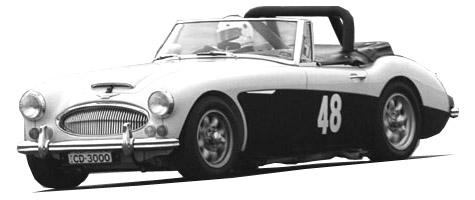
myaustinhealey.com - the 'black & white car' site
Austin Healey Technical articles & tips


These technical articles are provided to assist other Austin Healey enthusiasts in getting more out of their Healey in terms of competition performance. These articles are Copyright© Chris Dimmock 1999 - 2010. Many have been previously published in various forms in the AHOC NSW club magazine 'Flat Chat' or on the healeys@autox.team.net mailing list.
Disclaimer: I can take no responsibility for what you do to your car in the privacy of your own garage. There is no guarantee that the issues discussed here will be suitable for you, your car, or the purpose for which you use your car. I can take no responsibility for anything you do to your car - it is your car - you can do what you like - but don't blame me. This information is based on what I have done, or researched - but it is not a full step by step workshop manual guide - so if you don't understand the implications or processes - then don't attempt it. E & OE. No animals were harmed during the writing of these articles. I trust that covers all the required disclaimers.......
If you want to reproduce any of these in a Healey Club mag - please
I've recently added the data and pictures on the Austin Healey 3000 Cylinder head casting AEC960 and Spark plug depth issues which I've discussed for many years, on it's own page.
Some observations on Healey Sway bar fitment
For those of you who have fitted a larger e.g. 7/8 inch diameter front sway bar - and still have their front bumper bar fitted to the car - here's something you may care to check.
On my BJ8, I noticed there was very little clearance between the bottom of the bumper bar bracket, and the top edge of the sway bar arms. The shiny marks on the bottom edge of the bumper bracket - and corresponding marks on the sway bar at the 'corners' - confirmed my suspicion - the 'arms' of the larger diameter bar were hitting the bumper bar bracket. This is a bad thing. If the swaybar arms hit/ bind on the bumper bracket, they will limit the suspension movement causing understeer.
However, the situation is easily remedied. Mark the width of the swaybar on the bumperbar bracket - and the location of the two (per side) bumperbar location bolts to the chassis (which helps when you go to refit the bumper bar to the car - in the same location - later!). Remove the front bumperbar with its brackets, and, using a large semicircular file (or angle grinder), file/ grind the offending area of the bumperbar bracket, in a nice 'scallop', so it clears the sway bar 'arms'. You need to allow about an extra .25 of an inch (probably more if you have standard springs) either side (especially to the rear) of the rollbar diameter, to allow for the movement of the bar arms. The depth of the scallop you file will (depending on how stiff your front springs are) have to be at least .25in to .4in deep directly above the centre of the rollbar - possibly more if you have original 'soft' front springs.
If you are driving close to the limit when the suspension becomes 'solid' - i.e. when the swaybar arms bind on the bumper bar bracket - your Healey will understeer badly. So - its worth checking - especially if you have a heavier front sway bar fitted.
Oils ain't oils....
So which type of oil should you use in a Healey overdrive gearbox? I spent a hell of a lot of time quite a while back trying to research this quandary.
Why is this such an issue? Primarily because the literature on the subject is confusing and contradictory. Here are the basic issues I uncovered. It appears the Healey gearbox/ overdrive requires a lubricant which satisfies seven criteria:
1. Overdrives are operated hydraulically - ie pressure is what makes the overdrive operate - so the oil has to also act as a hydraulic fluid.
2. The Overdrive has a wet clutch - ie there is a clutch which spends its life inmmersed in oil (like motorcycles)
3. Syncromesh operates on the gears using friction - ie if you reduce the friction, (as in use a 'friction modified oil' ) - then the syncros won't operate correctly
4. Temperature is also an issue - typically Non synthetic (i.e. mineral based) engine oil is thinner at lower temperatures than gear oil (not such an issue with synthetic engine oil)
5. Pre BJ8 gearboxes have brass rather than steel syncros - and 'older' EP mineral gearoils apparently have additives which attack the brass - (hence I believe the 'traditional' factory statement about using engine oil rather than gearoil)
6. The oil has to be capable of lubricating the gearbox - i.e. provide 'shear' protection in an environment which is like a box full of eggbeaters i.e. gearboxes aerate oil by their design. And - refer to point 1 above - no hydraulic system can operate successfully with aerated lubricant
7. Gearboxes don't have a filter like car engines - so having an engine oil which is designed to 'carry around' the impurities in suspension (by addition of detergents) - so that they can be removed by the filter - probably isn't a good idea in a gearbox - better to let any imputities settle on the bottom...
I think the 'gear oil versus engine oil' issue is a bit of a red herring in 2001. The 1950's - 60's BMC 'gearbox oil strategy" - I believe - was based on what was "practical & commercial & available" - rather than purely technical issues.... and it doesn't take into account the technological advancements made over the past 40 years - eg Synthetic oils. Would anyone seriously argue that their car handled better on the original fitment crossply tyres than on say Yokohama A008RS assymetric directional radials today?
Original BMC literature says said the Healey gearbox & overdrive should use a MINERAL engine oil. But the exact same overdrive (which is fitted on the back of the gearbox - and uses the same oil as the gearbox) on a big Healey is also fitted to a Triumph - and guess what? Triumph's literature all says only use a gear oil...aaaaaarrgghhh
Whats the answer? I asked everyone. You name a Healey racer or Australian / English Healey specialist - and I have either phoned or emailed them. I even emailed the manufacturer of the Healey overdrive to ask them why Austin Healey & Triumph gave contrary advice on oil for their product. And guess what? The correct answer is... that there is no correct magic single answer.
But - the best advice I can give from my research, is:
1. If you want to use a mineral based oil - Most experts agreed that Brass syncro gearboxes (eg BN1 etc) should probably use engine oil. This is because SOME MINERAL gear oils have additives which can corrode some brass syncros - so to be safe - always use an engine oil if you have brass syncros or use a SYNTHETIC gearbox oil.
2. However, if you do use an engine oil - all experts agreed that you should NEVER use a 'friction modified" engine oil. Because a syncro cone relies on friction - i.e. a syncros whole purpose is to 'slow' the gear, in order for the gear to be easily selected - i.e. it relies on friction to operate... . If the oil is too slippery (ie friction modified) - then guess what - the syncro won't work - new oil and real slow graunchy gearchanges (do you like that word - I do - graunchy) !! That is the major reason many people use eg Penrite HPR (30 or 40) - a mineral engine oil which doesn't have friction modifiers - in their gearboxes.
3. It was unanimous that lubricants have come a long way in the past 40 years. Just because the factory used a particular tyre 40 years ago - it doesn't mean they would use the same tyres again today. My point - oils aren't the same today as they were in the 1950's. Synthetic oils were not in the mass market back then.
4. Engine oil tends to aerate more than gear oil - and tend to hold the bits of metal etc. in suspension (the properties of engine oil are designed to hold in suspension the by products of combustion - and remove them via a filter) Gear oils are designed for a Gear box which doesn't have a filter (note that your overdrive has a 'strainer' - not a filter)
Much of this research pointed towards a synthetic gear oil as the answer.
My advice - read the stuff at Redline Oil website and make up your own mind, based on your own use of the car. Personally - in my fully rebuilt, using 95% brand new parts (all new gears, all new shafts, all new bearings, all new seals, all new syncros - only used the 'original' selector forks & 3/4th syncroniser & casing) gearbox in my Healey 3000 - and a fully rebuilt overdrive - the transformation achieved by switching to Redline MT90 gear oil was amazing - and that was after I tried 4 different brands of non synthetic engine oil . Redline is not cheap compared to Penrite HPR 30 (which I was using just prior to the change to Redline) - but believe me - either was my gearbox/ overdrive....... I've been running Redline MT90 in my gearbox/overdrive for over 2 years now - and Redline 75W90 in the diff (either a Detroit locker 4.1:1 - or a Quaiffe 3.9:1 - depends where I am) and have quicker syncro, no selection issues, and the Redline oil is coloured for temperature monitoring - so you can actually tell by the colour of the oil (on the dipstick) how hot your oil is getting.
Hope this helps someone else get more enjoyment out of their Healey.
Armstrong shock arms - a mostly ficticious story....
Once upon a time, a long time ago, near the mythical village of Birmingham, there were 2 identical twin brothers - separated at birth - who were destined to shape the lives of many, many thousands of future British car owners.
One of these brothers was born "visually challenged" - and was called "Lucas". Lucas became quite bitter, and dedicated himself to ensuring that everyone else should have some insight to his world of darkness. The other brother - who exhibited large amounts of upper body strength - was known as "Armstrong".
The story of Lucas is well documented (mostly in Braille). This is part of the story of Armstrong - the younger, and stronger, brother - who went on to pioneer shock absorber damping to generations of British vehicles.
Armstrong - although credited with huge amounts of upper body strength - had little or no stamina (due, I think, to a genetic design defect). He was able to resist and contain huge forces - but generally only for a short period of time. Left under physical stress for any length of time, he would, without warning, spew copious amounts of a substance resembling light oil from his armpits. It was this socially unacceptable personal behavior which I believe prevented him from attaining international acceptance in the motoring industry:- this behavior remains a repeatable mystery to this day by all his siblings & descendants. This weakness - not unlike the fabled Achilles and his heel - is know in medical circles as "Armstrong armpit".
Sprite owners front shocks appear to be descendant from "Rear Admiral Armstrong"- known as "Lefty" to his mates - a distant relative, who, unfortunately lost an arm in a horrific naval accident. Although physically different in appearance, these single arm front shock absorbers also exhibit "Armstrong armpit". It should be noted that all big and little Healey rear shock absorbers are descendants of "Lefty".
As we move forward to the late 1990's it has probably become evident to most Austin Healey owners that the Armstrong's have left many descendants - often identical in external appearance and features - except for slight differences in their internal valves, and arms (quantity, as noted above, and length/ shape) - but all identical in their affliction with "Armstrong armpit".
I am not aware of a permanent cure for "Armstrong armpit" - other than rebuilding by a competent expert - or replacement with rare NOS items.
The Armstrong family tree provides some benefits to Healey owners, and it is worth looking out for some of Armstrong's family, siblings, descendants and close relatives. For example, I have several sets of old front shocks, which although they look like a Big Healey front shock (some stamped 0008, some stamped 6945 - underneath the shocker in the machined recess - and came from Wolsley sedans), have arms 12mm, and 8mm (respectively) shorter than a Big Healey front shock - and this effectively moves a Healey's camber from the (standard) 1 degree positive camber to 1- 2 degrees of negative camber, depending on which shock arms you use. Both my Healeys had these (shorter arm front shocks) fitted to them. Definitely safer than bending arms.... You may also need to fit shorter (or adjustable) trackrods to your car if you alter the camber by more than 1 degree.
If you want to alter your camber - keep an eye out for some of these shocks....
Front Suspension, camber and tyres
What do you use your car for? If you just drive it around on the street - then I can't help you too much past this point. Most big Healeys have 1 degree positive camber as standard, and about 1mm toe in - so the outer edge must be the edge that wears first in straight line driving (i.e. - lets ignore the dynamics of cornering for a minute). Negative camber and toe out will wear the inner edge in straight line driving.
If you want front negative camber - to make the front of the car 'bite' better, and grip harder - this article may help - but it will move tyre wear from the outside edge to the inside edge of your tyres if you drive around on the street.
As a tyre corners hard, the outside tyre rolls over into a positive camber situation. As you turn the wheel - the caster applies some negative camber. When you start playing with camber - your final goal is to have the loaded tyre as 'vertical' as you can get it - to get more rubber on the road under hard cornering. On a Healey, with Yokohama A008 tyres - you actually need about 8 degrees total negative camber at 20 degrees turn in to achieve a vertical, fully loaded tyre. This total required negative camber is effectively caster plus static camber. Most standard Healeys have 1 degree positive camber, and somewhere between 0 degrees and 3 degrees of negative caster..... so getting this much neg camber is a bit of a task - and most never achieve anywhere near it...
If you want to change your camber to negative - there are four methods I am aware of:
1. You can bend the front shock arms, effectively shortening them - but I wouldn't ever recommend this - no one seems to know what the arms are actually made of - or how they are made (cast? forged?) - and the metalurgy could be a bit risky. I know many guys who have done this - I won't.
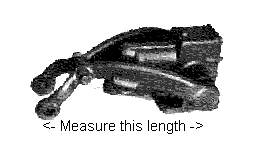
2. The better way is to fit the shorter front shock arms off other british cars - Wolesley sedans are the 'best' donors I've found. If you measure the length of your shock arms, centre to centre, with the shock arms installed on the shock, and you'll find that healey ones are 'about' 216 - 218mm long - try to measure them, and you'll see why I say 'about'.... You can get shock arms off other British sedans which are around 208mm, down to about 200mm long, trunion bolt center to shock arm pivot center. About 4.5mm = 1 degree of camber - so if you have a standard Healey setup (1 degree positive camber) - and you go to 200mm Wolseley arms - you get nearly 3 degrees NEGATIVE camber. But this modification (and most modifications which change camber by 2 degrees or more) require a few other changes - like making your fixed length steering arms adjustable, so you can shorten them to match the reduced shock arm length. You can't adjust the huge amount of toe out these shorter shock arms give by just shortening the centre fixed steeering rod - you will run out of adjustment - and the steering arm and idler arm - which must always piont forwards - will splay out at up to a 45degree angle. You'll need to align the idler arm and steering arm so they are pointing straight ahead - then shorten (and make adjustable) the fixed length side steering arms. If you aren't capable of doing this yourself - do some more research - and get a qualified suspension expert to look at what you are trying to achieve.
3. Use 'camber bushes' - offset bushes on the top trunion link of the king pin. Typically - these give around 1 degree of adjustment.
4. Another option if you are starting with a bare chassis is to move your front shock locating plates 'inwards' - same scale of distances as in 2. above. If you do this - then also move them "back" - and get some more caster while you are at it..... Healeys don't have enough caster to start with - and more caster = less negative static camber is required. But do your maths before you try this - and seek the serrvices of a professional welder or body aligner!! - and often your wishbone locating mounts on the chassis rail will also need to be altered - so that everything lines up when you are finished
Remember - more caster = heavier steering - but better cornering grip.
As always - measure accurately - know what you are trying to achieve, and what you want your car for. Everything is a compromise...
Fuel delivery pressure issues
Both SU's and Webers are very prone to leaking if your delivery pressure (totally different issue to volume) is excessive - irrespective of how good/new the float valve is. Most 'modern' type non SU fuel pumps operate at too high a pressure.
Why is this important? Because too much pressure can push the valve off its seat and cause a excessively rich air/fuel mixture - or worse - flooding. Too little pressure (or volume) - air/fuel mix is too lean.
If you don't have the equipment yourself - then most workshops that have a dyno setup, would be capable of measuring the:
1. Fuel delivery pressure:
(basically disconnect the fuel line from the carbs, connect a low pressure guage (ie something that accurately reads 0 -10lb) securely to the line, start the pump, and look at the guage. Delivery pressure for either SU's or Webers should be in the 3.5 preferred - 4 max lbs per square inch range - unless you have made major mods to the carbs themselves (eg a large ball bearing inside a weber instead of a std valve)2. Fuel delivery volume:
(basically disconnect the fuel line from the carbs, start the pump, and use a stop watch to ascertain how much fuel is delivered into a measured container over a measured amount of time). Most modern pumps deliver enough fuel. Your fuel volume requirement is obviously based on the state of tune of your engine; and how you drive it.If the volume is ok - but the pressure is too high - then you have 2 options - you can get a lower pressure pump - or fit a regulator. If you fit a regulator - my suggestion is the old fashioned Malpassi 'filter king' combined fuel filter & pressure regulator. They were fitted to italian high performance cars - like Masseratis - and are very 'period' in appearance. They often come up on ebay around $US50. Try searching for 'filter king' on Ebay. Most 'speed shops' sell just plain modern regulators. The 'flat' type regulators - usually annodised red or blue with a dial on top - seem to fail after about 12 months - from my research.
Once you have the regulator - fit it near the carbs - then back to the dyno man with the pressure guage - and adjust it to deliver 3.5lbs per square inch pressure - then recheck the delivery volume. The dyno man should be able to tell you what volume you need for your engine - which obviously depend on its state of tune.
The Malpassi regulator/filter is sort of cylindrical, alloy on top, with a glass filter bowl, and removeable paper filter and looks period.
Disclaimer: I can take no responsibility for what you do to your car in the privacy of your own garage. There is no guarantee that the issues discussed here will be suitable for you, your car, or the purpose for which you use your car. I can take no responsibility for anything you do to your car - it is your car - you can do what you like - but don't blame me. This information is based on what I have done, or researched - but it is not a full step by step workshop manual guide - so if you don't understand the implications or processes - then don't attempt it. E & OE. No animals were harmed during the writing of these articles. I trust that covers all the required disclaimers....... These articles are Copyright© Chris Dimmock 1999 - 2001. Many have been previously published in various forms in the AHOC NSW club magazine 'Flat Chat' or on the healeys@autox.team.net mailing list. If you want to reproduce any of these in a Healey Club mag - please
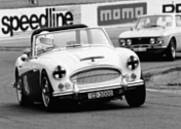
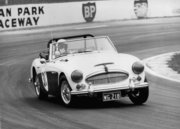
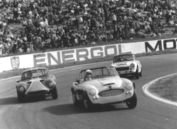
|
Ownership and competition history of the black & white 3000. Here is the entire history (including every competition event the black & white Healey has competed in) - from 1968 to 2001. |
||
|
|
The 1998 total restoration. The total restoration of the black & white Healey |
|
|
|
Technical Specifications and dynosheets. A summary of the specifications of the black & white Healey 3000, including dyno sheets. |
|
|
|
Austin Healey 3000 'black & white car' homepage. Back to myaustinhealey Austin healey home. |

All trademarks acknowledged.
Copyright© Chris Dimmock 2001 - 2010.
Not to be reproduced in whole
or in part without permission.
Site launched April 2001 - Last update 6th October, 2010.